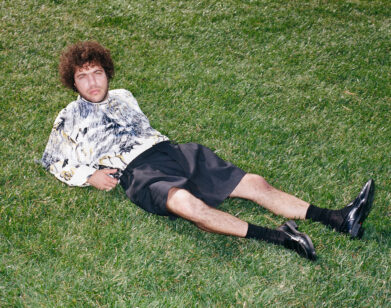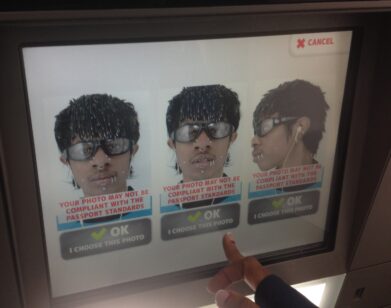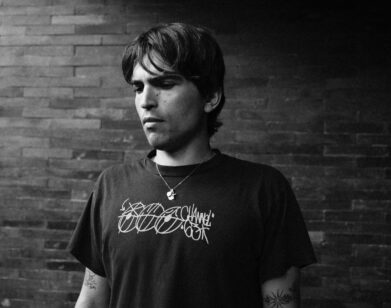Mount Kimbie and the Machine

ABOVE: MOUNT KIMBIE. IMAGE COURTESY OF CHRIS RHODES
Bedroom-producing their way onto the music scene in 2009, Mount Kimbie swam up from the underground to be charged with creating a new sound within the electronic genre. Scuttling synths, echoing field recordings and circular, dub-hinged beats framed Crooks & Lovers as a stand-alone anthem at the vanguard of post-dubstep.
It’s a tag Dominic Maker and Kai Campos have deliberately shed in writing their sophomore record, embracing the live performance experience to craft an album full of momentum—one that takes a confident step towards the dance floor. Though Cold Spring Fault Less Youth bears the polish of a professional studio, the Mount Kimbie grittiness is furthered with a percussive focus and the vocal contribution of King Krule, who casts his pained croon across two tracks. In anticipation of the album’s release, Maker spoke to Interview about starting over and the endless potential of drum machines.
TEMPE NAKISKA: So how was the experience of going back to write a second album?
DOMINIC MAKER: It was altogether different. The big change was that we had our own space, a studio without any frills. We also bought a few new pieces of gear that had a massive impact on the sound, like this Dave Smith drum machine which became a really core element of the album.
NAKISKA: You can feel that rhythmic influence right through every track.
MAKER: Yeah, we worked with Andy Ramsay, who was the drummer in Stereolab. In his studio he had a collection of 30 or 40 years’ worth of old drum machines. We had gone there with the intention of just recreating one song [“So Many Times, So Many Ways”] with live drums. But Andy had this old harmonium foot organ, and on playing it, we realized it would add this incredible new layer to every single track on the album.
NAKISKA: A less polished layer?
MAKER: Yeah. We had trialed a number of drummers and tried emulating the sound through the computer but it was too good, too tight. Like with the track “Blood & Form,” which was entirely based around the military beat. We used an old drum machine called “The Powerhouse,” a cartridge-loaded drum machine created by some Scottish guy who sat for hours recording himself playing acoustic drums, it goes out of tone in parts and it’s just great.
NAKISKA: Field recordings were such a massive part of your work previously; did you use that technique at all with this album?
MAKER: Actually, no. What I love about that technique is sitting down for a couple of hours and finding all these tiny new sounds within a recording. We got the same buzz out of recording at Andy’s studio; picking up a really old drum machine and literally recording everything that came out of it. It felt good to be able to express ourselves instantaneously. We didn’t know what the hell any of the knobs and buttons did, but that was half the fun of it.
NAKISKA: Speaking of sound, the album feels much “bigger” than Crooks & Lovers. How much of an impact did the experience of playing live between the albums have on writing?
MAKER: The beauty of a live show, for me, is the threat of something going wrong. People feel anxious or concerned if they can sense nervousness lingering on stage. We manually recorded a lot more of the sounds in, as opposed to working out the intricacies of automating the sound. From that perspective, it’s more like a live performance album.
NAKISKA: Via dubstep, you really developed your own language with Crooks & Lovers. Did you feel pressure to further than with the next album?
MAKER: I think the thing we took from listening to dubstep so much when we started out was that we were attracted to the space it gives you. With that album, we had the space but were restricted to a very small palette of sounds that we could use. So having time away from it and playing live was a real blessing; it got rid of the Crooks & Lovers sound still left in our blood.
NAKISKA: Was it a struggle, writing after touring for so long?
MAKER: To us, it felt like starting the band again; we felt like we had to hit the reset button. We were aware that the live stuff would influence what we were doing, so we tried to go back to the mindset we were in prior to touring.
NAKISKA: What about the move towards a dance vibe?
MAKER: For us, this album is more far-out than the last one. We had a lot of those moments where you look at each other and you’re like, “Fuck, this is really good,” but you have no idea what’s going on. I think that led to much of the kind of sound you’re talking about. Drum machines are obviously made to create dance music, so to an extent it was also the tether we were on. But we try to find loopholes in that close-knit house and dance community to find stuff we feel is interesting.
NAKISKA: So what were you listening to while writing the new album?
MAKER: William Basinski and Actress have been constant influences. Around the time of writing this album we were listening to a lot of Tame Impala and Micachu and the Shapes. Pop is quite heavily infused in all of those sounds, which is interesting because we’ve come to view Mount Kimbie songs as just small pop ideas taken in different directions to where the next person may take them.
NAKISKA: What was it like working with King Krule?
MAKER: Archie’s a really amazing talent. I didn’t really gauge the extent of his genius until he came in the studio and was just writing lyrics off the cuff. The way Archie writes his own music is similar to the way we work: he starts off with a really small idea and tries to expand from that microscopic concept. He really helped the direction of the tracks.
NAKISKA: What about your environment while writing—the new studio and your surroundings—did they have an impact?
MAKER: We wrote the album in South Bermondsey, which is the home of Millwall Football Club, it’s a docklands area. It’s all very industrial and quite a dangerous place, pretty run-down. I think we were also much more in touch with this area as the space we were working in, rather than being shut up in our bedrooms all the time. The journey to the studio was actually really influential, as you’d walk through Peckham where the old album was shot and all the photos from the front cover were literally in front of you. So then getting on a bus and going somewhere entirely different gave a real sense of a change in tone.
NAKISKA: You touched on live energy before. How are you feeling about playing the new material live?
MAKER: These are very bold songs for us, in the use of voice and drums and the way we’ve run with our ideas. It’s been a challenge working out how we were going to put that across live. With Crooks & Lovers, I think you can almost sense the nervousness because it’s constantly changing from one idea to the next. You could almost hide away from it onstage. But with this music it’s all or nothing.
COLD SPRING FAULT LESS YOUTH IS OUT TODAY. MOUNT KIMBIE PLAYS THE BOWERY BALLROOM ON MAY 30. FOR MORE ON THE BAND, CHECK OUT THEIR WEBSITE.






